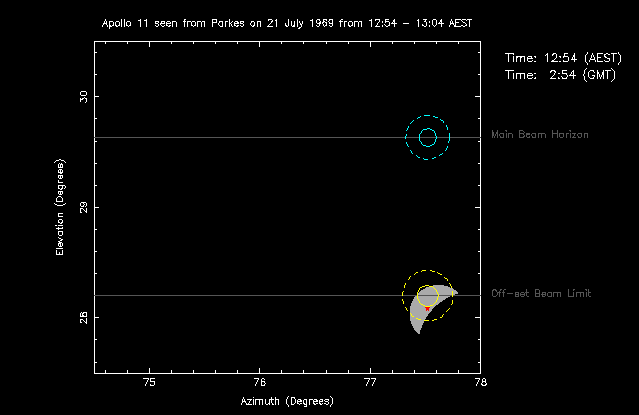 |
 |
The positions of the LM Eagle on 21 July 1969, are plotted as they were seen from Parkes from 12:54 to 13:04 (AEST).
The plot shows the positions of the Moon, the LM (red dot) and both the main and off-axis beams of the Parkes telescope. The positions of the Moon were calculated using JPL's DE102 program, which has an accuracy of about 5 arcseconds for the position of the Moon over the period 1850 to 2050 A.D. Corrections for atmospheric refraction were also taken into account. The LM positions were found by offsetting them the appropriate amount from the calculated centres of the Moon. The beam sizes and off-sets were supplied by Dr. Bruce Thomas.
The top horizontal line, is the horizon limit of the Parkes main beam. The bottom horizontal line is the limit of the off-axis beam. The blue circles indicate the position of the main beam and the yellow circles indicate the position of the offset beam. The solid circles indicate the half-power width of the beams (normally referred to as the beam widths). The dashed circles indicate the first null of the beam patterns.
Rotating the feed platform so that the off-axis receiver was directly above the main receiver, gave the off-axis receiver its maximum field-of-view below the main beam. It can be seen, that at 12:54 pm, the Parkes off-axis beam was in a position to receive the television signal from Apollo 11 just as it was switched on. The signal would have been slightly attenuated since it was not fully centred in the beam.
 The 6 day old Moon as it appeared from Parkes on 21 July 1969. |
Once the off-axis beam was horizontal and level with the main, on focus, beam, the telescope was moved quickly in azimuth to lock onto the radio source and track it in the main beam of the telescope.
It can be seen that by the time the Parkes pictures were included in the international broadcast, the source was clearly centred in the main beam.